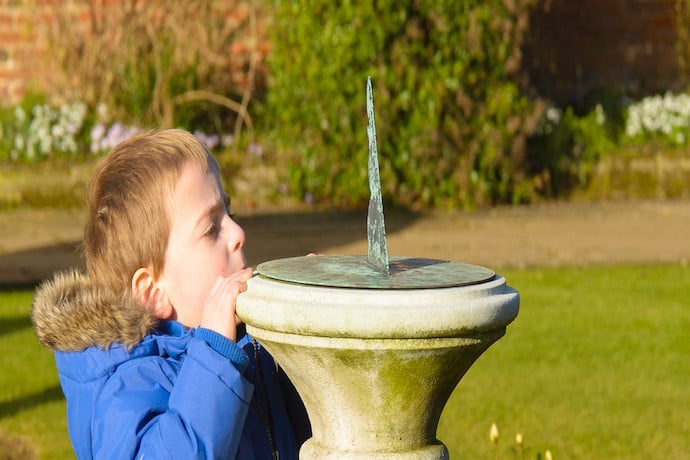What would happen if the clock on your classroom wall didn’t exist? If watches and other ways to read time didn’t exist? Could you get to school on time? Think of all the other ways would your life be impacted if clocks and the concept of time did not exist.
Time is a concept, but it’s also a technology because it helps people organize the activities in their lives. Without time, and clocks to keep track of time, life would be a lot less organized.
Sundials were the first technology created to measure time. Some sundials are still in use! A sundial is a flat surface with markers for hours of daylight, and a pole, called a gnomen. When the sun shines on the gnomen, the gnomen casts a shadow. As the sun moves across the sky, the shadow also moves from one hour marker to the next until sunset. While most people think of sundials as a flat surface with a gnomen above, the earliest sundials from ancient Greece and Egypt thousands of years ago were horizontal.
Sundials are easy to make. It all depends on your location. Where you are located south of the North Pole if you live in the northern hemisphere, or north of the South Pole if you live in the southern hemisphere, determines the angle of the gnomen and the accuracy of time kept with a sundial. To keep accurate local time, you deduct your latitude (which you can find out with an internet search engine) from 90. (90 degrees is the angle a gnomen would have at the North and South poles.)
While sundials worked well enough for thousands of years, eventually people tried to create more accurate ways to track time. Obviously, sundials don’t work at night. So people wondered if water could help keep track of time. Water turned out to be a natural way to create the earliest clocks, turning wooden or stone gears in a carefully calculated, consistent rhythm and speed.
In the Middle Ages in Europe, water clocks evolved into clocks with wind up gears. The Metropolitan Museum in New York had a show recently with a collection of these amazing, often elaborate clocks, as well as automatons. Automatons are somewhat self-operating machines or mechanisms to create motion that resembles human or animal actions. The exhibit also included an ornate pocket sundial.
The modern way we measure time did not exist until the railroads began crossing large areas in the mid-1800s. Trains needed to have a common way to track arrival and departure times from cities that were hours or days apart. Countries with a lot of land, like the United States, were divided into time zones. Eventually all countries saw the need to agree on a consistent way of keeping time. This is how Greenwich Mean Time (or GMT) came into being, GMT is kept in Greenwich in the UK. The observatory broadcasts an hourly signal which other locations use as a reference to calculate time in their time zone. For example, EST (Eastern Standard Time) which is the time zone for the eastern part of the United States, is five hours behind GMT. So EST is GMT-5. Check out the GMT website at www.greenwichmeantime.com.
Today we keep track of time with GMT, but also with atomic clocks. These are more precise than sundials or mechanical clocks. Our computers and phones keep time by checking the network for the latest time. And instead of a stick or gnomen casting a shadow to keep time, we get a digital readout on our computers and watches. School room clocks often use the older clock design with rotating short hands and long hand to track time relative to 12 hours. Sometimes you’ll hear them referred to as “analog” clocks.
Learn More Links:
Making Marvels exhibition: clocks, automatons
https://www.metmuseum.org/exhibitions/listings/2019/making-marvels-science-splendor
GMT
https://en.wikipedia.org/wiki/Greenwich_Mean_Time
How to Make a Sundial
https://en.wikipedia.org/wiki/History_of_sundials
Sundials from around the world
https://www.shadowspro.com/en/world-sundials.html
Positioning a Sundial
https://www.yardenvy.com/diy/positioning-a-sundial.htm
Is a Sundial Accurate?
https://www.macmillanhunter.co.uk/time/reading-a-sundial/is-a-sundial-accurate/
History of Timekeeping Devices
https://en.wikipedia.org/wiki/History_of_timekeeping_devices
Clocks
https://en.wikipedia.org/wiki/Clock
History of Telling Time
https://brombergs.com/a-history-of-telling-time-from-ancient-times-to-the-mechanical-wristwatch/
History and Science of Sundials
https://www.timecenter.com/articles/when-time-began-the-history-and-science-of-sundials/
Strange and interesting sundials
https://sciencing.com/strange-interesting-sundials-8631377.html
Brief history of telling time
http://theconversation.com/a-brief-history-of-telling-time-55408
History of telling time
http://www.time-for-time.com/history.htm
The future of telling time
https://www.cnet.com/news/nail-watch-the-future-of-telling-time/
New Era Atomic Clocks
https://www.nist.gov/news-events/news/2014/02/new-era-atomic-clocks

